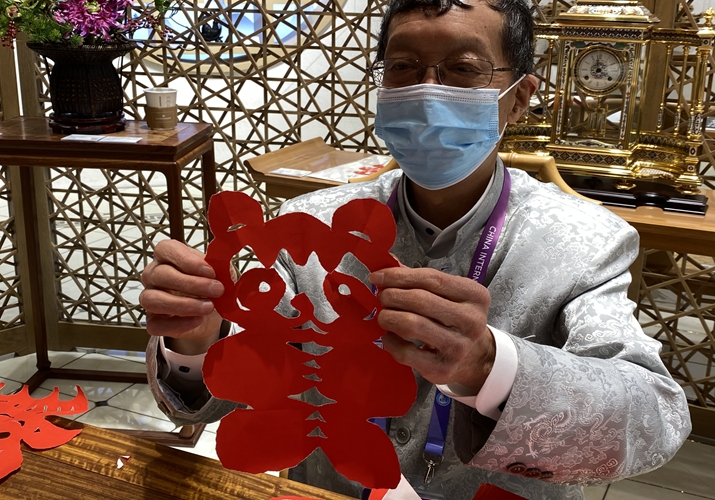| China |
| Intangible cultural heritage has been an embedded part of every CIIE | |
|
|
 Hua Xingfu, an inheritor of paper tearing art, demonstrates the form at the China International Import Expo media center in Shanghai on November 4 (YUAN YUAN) At this year's China International Import Expo (CIIE) in Shanghai, one man has drawn the attention of reporters and photographers alike. Sitting in a corner of the media center on November 4, the man has been demonstrating the ancient Chinese art of paper tearing.
Seventy-five-year-old Shanghai native, Hua Xingfu received an invitation to demonstrate the art form from expo organizers ten days ago. "Paper cutting is a well-known traditional craft in China," Hua told Beijing Review. "But paper tearing is known to relatively few. I am currently one of the few inheritors of this cultural heritage, so it's good to showcase the craft at this large event so it can become more widely known."
Hua's interest in paper tearing began when, as a teenager, he came across a craftsman tearing paper on the street in Shanghai. Hua was awed by the craftsman's skillful tearing of the paper. Using no tools, the craftsman tore the paper with his bare hands to create vivid and intricate patterns as Hua watched on. Where the more widely-known Chinese art of paper cutting requires delicacy and precision, paper tearing uses a more freestyle technique to create its shapes and patterns.
From the time Hua met the craftsman, he began teaching himself paper tearing and continued to practice throughout his teenage years. After completing his schooling, Hua began working in a printing house, making use of the scrap paper to practice his art in his spare time, while always hoping to once again meet the same craftsman he'd encountered years earlier. One evening, as he returned home from work, he came across a small performance by local craftsman being held in a shopping mall and was surprised to find the man he was looking for. "Coincidence?" Hua asked Beijing Review. "I think not. He accepted me as his student from that day."
The round shape, the crescent moon shape and straight or curved lines are the basic patterns of this art. "You can make almost everything from these basic elements," Hua said. "Before you begin, you should have the picture that you want to create in your mind. But unlike paper cutting, we don't have any set patterns and we leave enough room for innovation."
After retirement, Hua has spent almost all of his time on paper tearing. His mentor, the original craftsman Hua met on the street, is named Hu Lide, is now 92 years old, and is still tearing paper.
In 2015, paper tearing was listed as a form of intangible cultural heritage in Shanghai and Hua was identified as an inheritor of this art. Now he is mentoring his own student, a man in 40s.
There are no two identical paper tearing works in the world," Hua said. "I hope that this art will become known to more people and that more young people will be able to enjoy the fun of paper tearing."
In the following days, other forms of intangible cultural heritage will be displayed in this corner of the expo media center, including knitting and ink ingot making. Now in its third year, the CIIE has always supported the popularization of China's intangible cultural heritage, examples of which have been among the most important displays among the pavilions.
(Reporting from Shanghai)
Copyedited by Garth Wilson
Comments to yuanyuan@bjreview.com
|
|
||||||||||||||||||||||||||||||
|